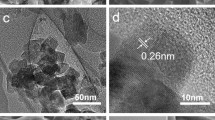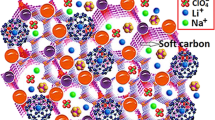Abstract
Li-ion hybrid supercapacitors (Li-HECs) facilitate effective combination of the advantages of supercapacitors and Li-ion batteries (LIBs). However, challenges remain in designing and preparing suitable anode and cathode materials, which often require tedious and expensive procedures. Herein, we demonstrated that hollow N-doped carbon capsules (HNC) with and without a Fe3O4 nanoparticle core can respectively function as the anode and the cathode in very-high-performance Li-HECs. The Fe3O4@NC anode exhibited a high reversible specific capacity exceeding 1530 mA h g−1 at 100 mA g−1 and excellent rate capability (45% capacity retention from 0.1 to 5 A g−1) and cycle stability (>97% retention after 100 cycles). Moreover, high rate performance was achieved in a full-cell using the HNC cathode. By combining the respective structural advantages of the components, the hybrid device with Fe3O4@NC//HNC exhibited a remarkable energy density of 185 W h kg−1 at a power density of 39 W kg−1. The hybrid device furnished a battery-inaccessible power density of 28 kW kg−1 with rapid charging/discharging within 9 s at an energy density of 95 W h kg−1.
摘要
锂离子混合电容器是一种集合了超级电容器和锂离子电池双重优点的储能器件. 然而, 正负极电极材料的选择和设计仍存在着巨 大的挑战. 本文采用水热反应与热处理相结合的方法, 合成了四氧化三铁纳米颗粒填充的氮掺杂碳胶囊负极材料(Fe3O4@NC), 用稀酸洗去 Fe3O4核, 得到中空的氮掺杂碳胶囊正极材料(HNC), 并测定了其作为锂离子混合电容器电极材料的性能. 结果表明, Fe3O4@NC负极材料在 100 mA g−1电流密度下具有1530 mA h g−1的容量, 且具有优异的倍率性能和循环稳定性. 同时HNC正极材料确保锂离子混合电容器具有大 倍率性能. 结合上述正负极材料的优点, Fe3O4@NC//HNC锂离子混合电容器在39Wkg−1的功率密度下表现出185Wh kg−1的能量密度, 并且 当该锂离子混合电容器的能量密度为95Wkg−1时, 其功率密度可高达28 kW kg−1. 本文采用的制备电极材料的方法操作简便, 廉价易得, 组 装成的锂离子混合电容器具有优异的能量密度和功率密度, 为新型锂离子混合电容器电极材料的设计提供了新思路
Similar content being viewed by others
References
Armand M, Tarascon JM. Building better batteries. Nature, 2008, 451: 652–657
Wang G, Zhang L, Zhang J. A review of electrode materials for electrochemical supercapacitors. Chem Soc Rev, 2012, 41: 797–828
Amatucci GG, Badway F, Du Pasquier A, et al. An asymmetric hybrid nonaqueous energy storage cell. J Electrochem Soc, 2001, 148: A930–939
Plitz I, Dupasquier A, Badway F, et al. The design of alternative nonaqueous high power chemistries. Appl Phys A, 2006, 82: 615–626
Naoi K, Naoi W, Aoyagi S, et al. New generation “nanohybrid supercapacitor”. Acc Chem Res, 2013, 46: 1075–1083
Wang Y, Xia Y. Recent progress in supercapacitors: from materials design to system construction. Adv Mater, 2013, 25: 5336–5342
Aravindan V, Gnanaraj J, Lee YS, et al. Insertion-type electrodes for nonaqueous Li-ion capacitors. Chem Rev, 2014, 114: 11619–11635
Dubal DP, Ayyad O, Ruiz V, et al. Hybrid energy storage: themerging of battery and supercapacitor chemistries. Chem SocRev, 2015, 44: 1777–1790
Ma Y, Chang H, Zhang M, et al. Graphene-based materials for lithium-ion hybrid supercapacitors. Adv Mater, 2015, 27: 5296–5308
Choi HS, Im JH, Kim TH, et al. Advanced energy storage device: a hybrid BatCap system consisting of battery–supercapacitor hybrid electrodes based on Li4Ti5O12–activated-carbon hybrid nanotubes. J Mater Chem, 2012, 22: 16986–16993
Iwama E, Kawabata N, Nishio N, et al. Enhanced electrochemical performance of ultracentrifugation-derived nc-Li3VO4/MWCNT composites for hybrid supercapacitors. ACS Nano, 2016, 10: 5398–5404
Yang M, Zhong Y, Ren J, et al. Fabrication of high-power Li-ion hybrid supercapacitors by enhancing the exterior surface charge storage. Adv Energ Mater, 2015, 5: 1500550
Zhang F, Zhang T, Yang X, et al. A high-performance supercapacitor- battery hybrid energy storage device based on graphene-enhanced electrode materials with ultrahigh energy density. Energ Environ Sci, 2013, 6: 1623–1632
Yi R, Chen S, Song J, et al. High-performance hybrid supercapacitor enabled by a high-rate Si-based anode. Adv FunctMater, 2014, 24: 7433–7439
Li B, Dai F, Xiao Q, et al. Nitrogen-doped activated carbon for a high energy hybrid supercapacitor. Energ Environ Sci, 2016, 9: 102–106
Li B, Dai F, Xiao Q, et al. Activated carbon from biomass transfer for high-energy density lithium-ion supercapacitors. Adv Energ Mater, 2016, 6: 1600802
Yang S, Feng X, Ivanovici S, et al. Fabrication of graphene-encapsulated oxide nanoparticles: towards high-performance anode materials for lithium storage. Angew Chem Int Ed, 2010, 49: 8408–8411
Piao Y, Kim HS, Sung YE, et al. Facile scalable synthesis of magnetitenanocrystals embedded in carbon matrix as superior anode materials for lithium-ion batteries. Chem Commun, 2010, 46: 118–120
Jiang H, Hu Y, Guo S, et al. Rational design of MnO/carbon nanopeapods with internal void space for high-rate and long-life Li-ion batteries. ACS Nano, 2014, 8: 6038–6046
Li H, Xu R, Wang Y, et al. In situ synthesis of hierarchical mesoporous Fe3O4@C nanowires derived from coordination polymers for high-performance lithium-ion batteries. RSC Adv, 2014, 4: 51960–51965
Wang H, Xu Z, Li Z, et al. Hybrid device employing three-dimensional arrays ofMnO in carbon nanosheets bridges battery–supercapacitor divide. Nano Lett, 2014, 14: 1987–1994
Mhamane D, Aravindan V, Kim MS, et al. Silica-assisted bottom- up synthesis of graphene-like high surface area carbon for highly efficient ultracapacitor and Li-ion hybrid capacitor applications. J Mater Chem A, 2016, 4: 5578–5591
Sennu P, Aravindan V, Ganesan M, et al. Biomass-derived electrode for next generation lithium-ion capacitors. ChemSusChem, 2016, 9: 849–854
Zhang LL, Zhao XS. Carbon-based materials as supercapacitor electrodes. Chem Soc Rev, 2009, 38: 2520–2531
Pandolfo AG, Hollenkamp AF. Carbon properties and their role in supercapacitors. J Power Sources, 2006, 157: 11–27
Li W, Zhang F, Dou Y, et al. A self-template strategy for the synthesis of mesoporous carbon nanofibers as advanced supercapacitor electrodes. Adv Energ Mater, 2011, 1: 382–386
Guo X, Liu P, Han J, et al. 3D nanoporous nitrogen-doped graphene with encapsulated RuO2 nanoparticles for Li-O2 batteries. Adv Mater, 2015, 27: 6137–6143
Qin K, Liu E, Li J, et al. Free-standing 3D nanoporous duct-like and hierarchical nanoporous graphene films for micron-level flexible solid-state asymmetric supercapacitors. Adv EnergMater, 2016, 6: 1600755
Han J, Guo X, Ito Y, et al. Effect of chemical doping on cathodic performance of bicontinuous nanoporous graphene for Li-O2 batteries. Adv Energ Mater, 2016, 6: 1501870
Zhou G, Wang DW, Li F, et al. Graphene-wrapped Fe3O4 anode material with improved reversible capacity and cyclic stability for lithium ion batteries. Chem Mater, 2010, 22: 5306–5313
Ferrari AC, Basko DM. Raman spectroscopy as a versatile tool for studying the properties of graphene. Nat Nanotech, 2013, 8: 235–246
Simon P, Gogotsi Y, Dunn B. Where do batteries end and supercapacitors begin? Science, 2014, 343: 1210–1211
Lim E, Kim H, Jo C, et al. Advanced hybrid supercapacitor based on a mesoporous niobium pentoxide/carbon as high-performance anode. ACS Nano, 2014, 8: 8968–8978
McIntyre NS, Zetaruk DG. X-ray photoelectron spectroscopic studies of iron oxides. Anal Chem, 1977, 49: 1521–1529
Poulin S, Franca R, Moreau-Belanger L, et al. Confirmation of X-ray photoelectron spectroscopy peak attributions of nanoparticulate iron oxides, using symmetric peak component line shapes. J Phys Chem C, 2010, 114: 10711–10718
Wilson D, Langell MA. XPS analysis of oleylamine/oleic acid capped Fe3O4 nanoparticles as a function of temperature. Appl Surface Sci, 2014, 303: 6–13
Biesinger MC, Payne BP, Grosvenor AP, et al. Resolving surface chemical states in XPS analysis of first row transitionmetals, oxides and hydroxides: Cr,Mn, Fe, Co andNi. Appl Surface Sci, 2011, 257: 2717–2730
Eltouny NA, Ariya PA. Fe3O4 nanoparticles and carboxymethyl cellulose: a green option for the removal of atmospheric benzene, toluene, ethylbenzene, and o-xylene (BTEX). Ind Eng Chem Res, 2012, 51: 12787–12795
He Y, Huang L, Cai JS, et al. Structure and electrochemical performance of nanostructured Fe3O4/carbon nanotube composites as anodes for lithium ion batteries. Electrochim Acta, 2010, 55: 1140–1144
Wang JZ, Zhong C, Wexler D, et al. Graphene-encapsulated Fe3O4 nanoparticles with 3D laminated structure as superior anode in lithium ion batteries. Chem Eur J, 2011, 17: 661–667
Chen Z, Yuan Y, Zhou H, et al. 3D nanocomposite architectures from carbon-nanotube-threaded nanocrystals for high-performance electrochemical energy storage. Adv Mater, 2014, 26: 339–345
Yan J, Fan Z, Sun W, et al. Advanced asymmetric supercapacitors based on Ni(OH)2/graphene and porous graphene electrodes with high energy density. Adv Funct Mater, 2012, 22: 2632–2641
Acknowledgments
This work was supported by the National Natural Science Foundation of China (51601127, 21603162 and 51671145), China Post-doctoral Science Fund (2015M581304), Tianjin Municipal Education Commission, Tianjin Municipal Science and Technology Commission (16ZXCLGX00120) and the Fundamental Research Funds of Tianjin University of Technology.
Author information
Authors and Affiliations
Corresponding author
Additional information
Cuihua An is currently a research scientist at Tianjin University of Technology (TUT). She received her PhD degree from Nankai University in 2015, and then joined the Institute for New Energy Materials & Low-Carbon Technologies at TUT as a postdoctor. Her research focuses on the design and synthesis of nano/micromaterials and their applications in Li ion batteries and supercapacitors.
Xizheng Liu is currently an associate professor at TUT. He received his PhD degree from the University of Tsukuba in 2014, and then worked as a postdoctor in AIST, Japan, from 2014 to 2015. He joined the Institute for New Energy Materials & Low-Carbon Technologies at TUT in Aug. 2015. His research interests include the development of novel electrode materials for Li/Na ion batteries, supercapacitor, metal-air battery and the related electrochemical reaction mechanisms.
Yi Ding is currently a distinguished professor at the Institute for New Energy Materials & Low-Carbon Technologies, TUT. He received his PhD degree from Johns Hopkins University in 2005, and then took a faculty position at Shandong University as a Tai-Shan Scholar. In Jan. 2015, he moved to TUT to establish Tianjin Key Laboratory of Advanced Functional Porous Materials. His research interests focus on creating functional nanoporous metal materials for the use in advanced energy technologies. He has been granted 30 patents and published 100 journal articles, with a total citation over 7000 times and an H-index of 45.
Electronic supplementary material
40843_2016_9007_MOESM1_ESM.pdf
Filling and unfilling carbon capsules with transitional metal oxide nanoparticles for Li-ion hybrid supercapacitors: towards hundred grade energy density
Rights and permissions
About this article
Cite this article
An, C., Liu, X., Gao, Z. et al. Filling and unfilling carbon capsules with transition metal oxide nanoparticles for Li-ion hybrid supercapacitors: towards hundred grade energy density. Sci. China Mater. 60, 217–227 (2017). https://doi.org/10.1007/s40843-016-9007-2
Received:
Accepted:
Published:
Issue Date:
DOI: https://doi.org/10.1007/s40843-016-9007-2




